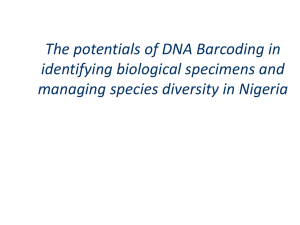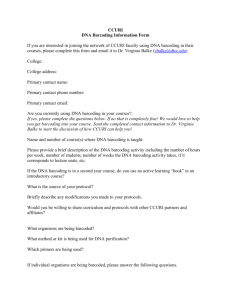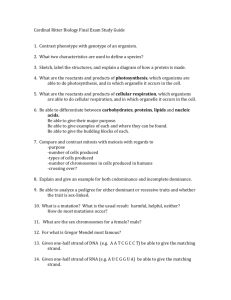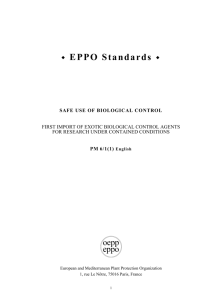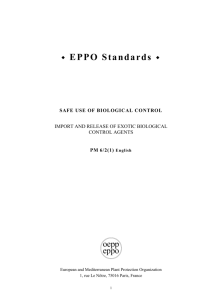Call for Test Performance Study participants draft EPPO
advertisement
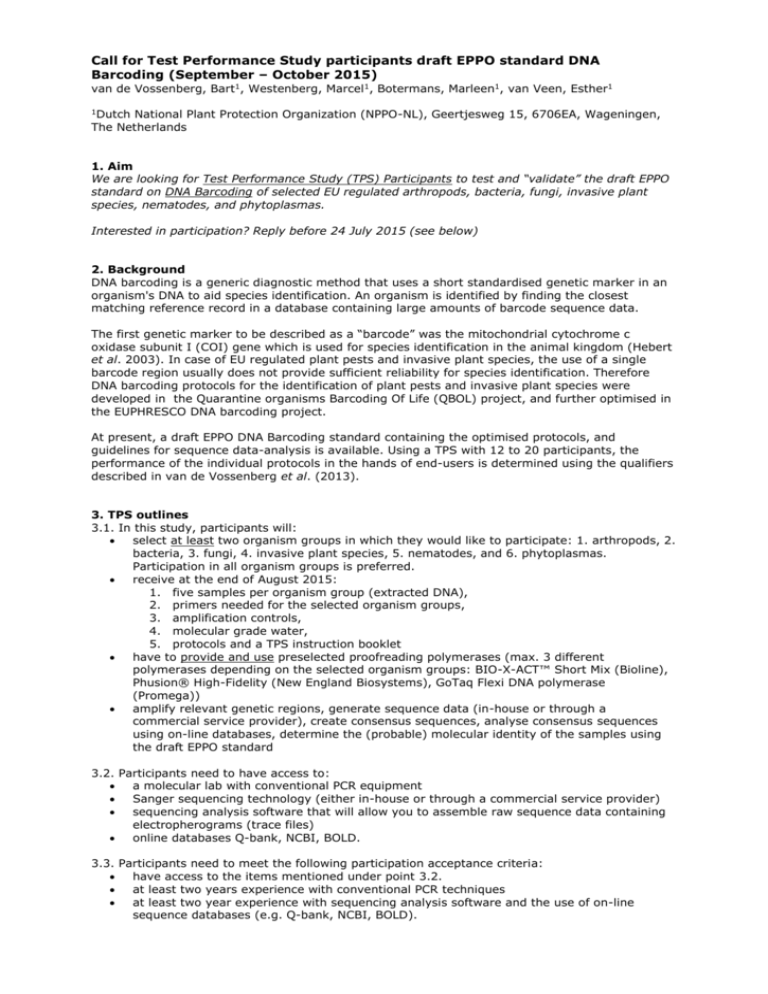
Call for Test Performance Study participants draft EPPO standard DNA Barcoding (September – October 2015) van de Vossenberg, Bart1, Westenberg, Marcel1, Botermans, Marleen1, van Veen, Esther1 1Dutch National Plant Protection Organization (NPPO-NL), Geertjesweg 15, 6706EA, Wageningen, The Netherlands 1. Aim We are looking for Test Performance Study (TPS) Participants to test and “validate” the draft EPPO standard on DNA Barcoding of selected EU regulated arthropods, bacteria, fungi, invasive plant species, nematodes, and phytoplasmas. Interested in participation? Reply before 24 July 2015 (see below) 2. Background DNA barcoding is a generic diagnostic method that uses a short standardised genetic marker in an organism's DNA to aid species identification. An organism is identified by finding the closest matching reference record in a database containing large amounts of barcode sequence data. The first genetic marker to be described as a “barcode” was the mitochondrial cytochrome c oxidase subunit I (COI) gene which is used for species identification in the animal kingdom (Hebert et al. 2003). In case of EU regulated plant pests and invasive plant species, the use of a single barcode region usually does not provide sufficient reliability for species identification. Therefore DNA barcoding protocols for the identification of plant pests and invasive plant species were developed in the Quarantine organisms Barcoding Of Life (QBOL) project, and further optimised in the EUPHRESCO DNA barcoding project. At present, a draft EPPO DNA Barcoding standard containing the optimised protocols, and guidelines for sequence data-analysis is available. Using a TPS with 12 to 20 participants, the performance of the individual protocols in the hands of end-users is determined using the qualifiers described in van de Vossenberg et al. (2013). 3. TPS outlines 3.1. In this study, participants will: select at least two organism groups in which they would like to participate: 1. arthropods, 2. bacteria, 3. fungi, 4. invasive plant species, 5. nematodes, and 6. phytoplasmas. Participation in all organism groups is preferred. receive at the end of August 2015: 1. five samples per organism group (extracted DNA), 2. primers needed for the selected organism groups, 3. amplification controls, 4. molecular grade water, 5. protocols and a TPS instruction booklet have to provide and use preselected proofreading polymerases (max. 3 different polymerases depending on the selected organism groups: BIO-X-ACT™ Short Mix (Bioline), Phusion® High-Fidelity (New England Biosystems), GoTaq Flexi DNA polymerase (Promega)) amplify relevant genetic regions, generate sequence data (in-house or through a commercial service provider), create consensus sequences, analyse consensus sequences using on-line databases, determine the (probable) molecular identity of the samples using the draft EPPO standard 3.2. Participants need to have access to: a molecular lab with conventional PCR equipment Sanger sequencing technology (either in-house or through a commercial service provider) sequencing analysis software that will allow you to assemble raw sequence data containing electropherograms (trace files) online databases Q-bank, NCBI, BOLD. 3.3. Participants need to meet the following participation acceptance criteria: have access to the items mentioned under point 3.2. at least two years experience with conventional PCR techniques at least two year experience with sequencing analysis software and the use of on-line sequence databases (e.g. Q-bank, NCBI, BOLD). are able to perform the DNA Barcoding tests (PCR tests and sequence analysis) on their own costs (except for items mentioned under 3.1) on at least 10 samples (5 samples per organism groups x 2 organism groups) in September and October 2015. Results have to be reported in the first week of November 2015. 4. Output 4.1. TPS results will be made publically available: as a paper in the EPPO bulletin (participating labs will mentioned in the paper and acknowledged. Individual laboratory results will be presented anonymously) as validation data in the EPPO standard on DNA Barcoding (EPPO validation sheets) Participants will not receive individual results per laboratory (as is common for a proficiency test; PT), but an EPPO validation sheet for each organism group. 5. Registration of interest Should you be interested in participation in this TPS, please complete the table below and send it to Esther van Veen (e.j.vanveen@nvwa.nl) before 24 July 2015 Should you have any questions in regard to participation or the TPS set-up, contact Bart van de Vossenberg (b.t.l.h.vandevossenberg@nvwa.nl). Registration of Interest By completing the registration form and sending it to the TPS organiser, you state that you meet the participation acceptance criteria as stated under section 3.3. First name Family name e-mail address Telephone number Institute (full name) Institute (acronym) Address (Please state address where the TPS package should be shipped to no P.O.-box) Country My institute would like to participate for the following organism groups (indicate with “x”) Arthropods (3 tests1) Bacteria (6 tests) Fungi (6 tests) Invasive plants (2 tests) 1 Nematodes (3 tests) Phytoplasmas (3 tests) the number of tests described in the draft EPPO standard per organism group. 6. Literature Hebert PDN, Cywinska A, Ball SL & deWaard JR (2003) Biological identifications through DNA barcodes. Proceedings of the Royal Society of London. Series B, Biological Sciences 270, 313–321. van de Vossenberg, B. T. L. H., Westenberg, M. and Bonants, P. J. M. (2013), DNA barcoding as an identification tool for selected EU-regulated plant pests: an international collaborative test performance study among 14 laboratories. EPPO Bulletin, 43: 216–228. doi: 10.1111/epp.12031


